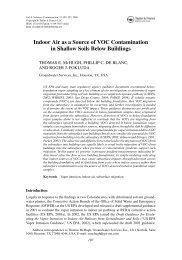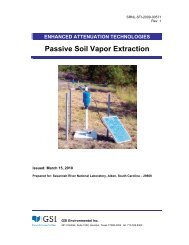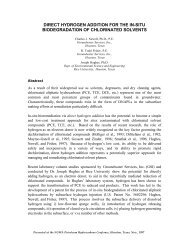Calculation and Use of First-Order Rate Constants for Monitored ...
Calculation and Use of First-Order Rate Constants for Monitored ...
Calculation and Use of First-Order Rate Constants for Monitored ...
You also want an ePaper? Increase the reach of your titles
YUMPU automatically turns print PDFs into web optimized ePapers that Google loves.
confidence interval can be calculated as the slower <strong>of</strong> the twoconfidence intervals from a “two-tailed” test that has twice theuncertainty. In the example above, where “two tailed” confidenceintervals were calculated <strong>for</strong> a confidence level <strong>of</strong> 80%, the truerate will be greater than a rate <strong>of</strong> 0.127 per year 90% <strong>of</strong> the time.The “one tailed” confidence intervals reported in the table belowwere calculated in this fashion. Monitoring well MW-5 has thehighest concentration <strong>of</strong> MTBE <strong>and</strong> the lowest Point Decay <strong>Rate</strong>,<strong>and</strong> can reasonably be expected to be the last monitoring well toreach the goal. The other monitoring wells should reach the goalmuch sooner; the best estimate <strong>of</strong> the lifetime <strong>of</strong> the plume is theexpected lifetime <strong>of</strong> MTBE in MW-5.Note that <strong>for</strong> a given number <strong>of</strong> observations, as the level <strong>of</strong>confidence is increased, the interval that is expected to containthe real value <strong>for</strong> the rate constant increases as well. As the level<strong>of</strong> confidence increases, the lower boundary on the rate constantdecreases, <strong>and</strong> the projected time required to meet the clean-upgoal increases. In the examples presented above, the estimatedrate <strong>of</strong> natural attenuation <strong>of</strong> MTBE in MW-5 is 0.188 per year,which requires 16 years to attain a concentration <strong>of</strong> 20 µg/L. At a90% confidence level, the lower boundary <strong>of</strong> the confidenceinterval is 0.127 per year, which requires 24 years to meet thegoal. At a 95% confidence level, the lower boundary is 0.109 peryear, which requires 28 years to reach the goal. At the 95%confidence level the upper bound <strong>of</strong> the time expected to reachthe clean-up goal has increased by a factor <strong>of</strong> almost two (from16 years to 28 years). This does not necessarily mean that theactual time to achieve cleanup will be 28 years; it simply meansthat the length <strong>of</strong> time that will actually be required is estimated tobe no more than 28 years at a 95% level <strong>of</strong> confidence.At many sites, the long-term monitoring data show that theconcentration <strong>of</strong> MTBE actually increases over time. At othersites, the general trend in the concentration <strong>of</strong> MTBE may bedown, but there is a great deal <strong>of</strong> variation in the data. Thesevariations in concentrations over time are not necessarily errorsin sampling <strong>and</strong> analysis <strong>of</strong> ground water. In many cases theyreflect real changes in the plume caused by seasonal variationsin precipitation. These variations are a natural property <strong>of</strong> plume.If the variation is large enough, one boundary <strong>of</strong> the “two tailed”confidence interval will be a positive number <strong>and</strong> the otherboundary will be a negative number. When zero is included inthe confidence interval on the rate, there is no evidence in thedata that the true rate is different from zero. If this is the case, it ispossible that attenuation is occurring in that particular well overtime, but the monitoring data do not present evidence thatattenuation is occurring at the predetermined level <strong>of</strong> confidence.At the predetermined level <strong>of</strong> confidence, it is impossible to predicthow long it will take to reach the clean-up goals.The ability to extract a rate <strong>of</strong> attenuation from long-term monitoringdata is related to the number <strong>of</strong> measurements, <strong>and</strong> the timeinterval over which they are collected. As an example, the rate <strong>of</strong>attenuation extracted from the last three years <strong>of</strong> monitoring data<strong>for</strong> well MW-5 (3/27/1998 to 6/22/2000) is 0.106 per year, but the“one tailed” 90% confidence interval is all rates greater than-0.125 per year. The confidence interval includes zero. If onlythese three years <strong>of</strong> data were available, there would be noevidence <strong>of</strong> natural attenuation <strong>of</strong> MTBE in well MW-5 at 90%confidence. The rate extracted from the last four years <strong>of</strong> data(5/17/1996 to 6/22/2000) is 0.130 per year. The 90% confidenceinterval on the rate (0.0302 per year) would reach the clean-upgoal in 100 years. The rate extracted using all the seven years <strong>of</strong>monitoring data is 0.188 per year. The 90% confidence intervalon the rate would reach cleanup in 24 years. A few extra years <strong>of</strong>monitoring data have a strong influence on the ability to extractuseful rate constants.Key Point:The Point Decay <strong>Rate</strong> (k point) can be used to project the timerequired <strong>for</strong> reaching a clean-up goal. However, there are anumber <strong>of</strong> points to keep in mind. <strong>First</strong>, an appreciable record <strong>of</strong>long-term monitoring data must be available to make a statisticallyvalid projection <strong>of</strong> the rate <strong>of</strong> natural attenuation. As a practicalmatter, it is difficult to extract rate constants that are statisticallysignificant with fewer than six sampling dates, or with a samplinginterval <strong>of</strong> less than three years. Second, it is unrealistic to expectjust a few years <strong>of</strong> monitoring data to accurately predict plumebehavior several decades into the future. Third, it is important torealize that these estimates are merely estimates <strong>and</strong> that thetrue rate may change over time.Table I-3. Point Decay <strong>Rate</strong> (k point) <strong>of</strong> Attenuation <strong>of</strong> MTBE in Monitoring Wells <strong>and</strong> the Projected Time Required to Reach aClean-Up Goal <strong>of</strong> 20 mg/L as Calculated from the Long-Term Monitoring Data <strong>for</strong> the WellsWell MTBE (µg/L) Estimated rate <strong>and</strong> timerequired<strong>Rate</strong> <strong>and</strong> time significantat 90% confidence<strong>Rate</strong> <strong>and</strong> time significantat 95% confidence<strong>First</strong>Sample1993LastSample2000<strong>Rate</strong>(per year)Time(years)<strong>Rate</strong>(per year)Time(years)<strong>Rate</strong>(per year)Time(years)MW-5 1900 420 0.188 16 0.127 24 0.109 28MW-11 2200 146 0.453 4.4 0.365 5.4 0.337 5.9MW-6 270 51.2 0.29 3.2 0.246 3.8 0.231 3.814






